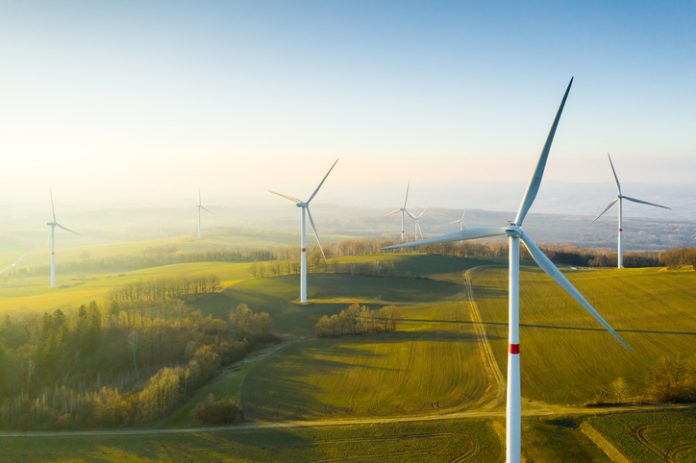By Miles Pollard
Shortly after naming Claire Coutinho as secretary of state for energy security and net zero on Aug. 31, British Prime Minister Rishi Sunak announced a plan to accelerate the approval process for onshore wind projects.
Previously, a 2015 ruling allowed a single complaint within a community to halt an onshore wind program and fully stopped subsidies for such projects.
Under the new rule, communities can speed up the process for allocating sites through local development orders or community right-to-build orders.
However, wind farms can drastically raise the cost of electricity when the wind doesn’t blow and could leak a chemical that is exponentially more harmful to the environment than carbon dioxide.
Perhaps Coutinho isn’t aware of the influential 2019 BBC article that uncovered how the U.K.’s offshore wind turbine gearboxes are utilizing the world’s most potent greenhouse gas, sulfur hexafluoride, and that these gearboxes are leaking 15% of the gas over their lifecycle.
Sulfur hexafluoride is 23,500 times more potent than carbon dioxide. For reference, methane and nitrous oxide are roughly 25 and 298 times more potent than carbon dioxide, respectively. Additionally, these estimates are only over a 100-year perspective, and sulfur hexafluoride could exist up to 3,200 years in the atmosphere. Consequently, a single pound of released sulfur hexafluoride is the equivalent of 11 tons of CO2 in the atmosphere.
No energy source, not even wind, can be fully without externalities, even with the most advanced recycling techniques. That’s not to mention the hydrocarbons needed to fabricate the nylon and fiberglass for blades and to create the steel and concrete for towers.
Speaking of externalities, Coutinho should also acknowledge the potential of 100,000 birds killed every year by wind turbines in the U.K. However, losses could be minimized by adopting the Norwegian practice of painting one rotor blade black to reduce those deaths by an estimated 70%.
Despite the calls for expansion of energy generation, one of the largest hurdles is the time it takes to link to the grid, with more than 1,100 projects currently waiting to connect. With such a backlog of projects and the lack of transmission infrastructure, the U.K. government should contemplate allowing these projects to compete in an unsubsidized market to weed out economically unviable projects and restore reliability and adaptability to the grid.
Furthermore, the U.K. should also be wary of greenlighting or expanding every wind project without completing the due diligence to investigate local environmental harm and to acknowledge the wishes of local constituents.
Abandoning reliable generation capacity for intermittent wind power without first investing in viable storage capacity is a recipe for disaster.
For example, scalable gas-fired power stations saved the U.K. last winter by providing 60% of the needed electricity while wind turbines contributed a paltry 3%.
In order to end the economic malaise caused by ever-increasing energy prices and a culture of strangling economic freedom into stagnation, the U.K. needs to adopt an energy policy that will lower prices of electricity, rather than adopting the German model of closing reliable nuclear power stations and massively expanding intermittent solar and wind. Instead, the U.K. should adopt the Trump-era all-of-the-above strategy for energy security.
Similarly, the U.K. should roll back pre-Brexit European laws and rebuff current proposed measures that seek to control people’s everyday lives, such as mandating that properties meet net-zero targets or pay 15,000 pounds (about $18,750).
In an economic climate of spiraling inflation, the U.K. government should look to all avenues, including retaining its coal power until viable base-load generation alternatives can be secured.
The U.K.’s remaining nuclear reactors should be left online or expanded, and small modular nuclear reactors should be explored. Rather than solely expanding wind turbines that could leak a greenhouse gas 23,500 times more potent than CO2, the U.K. should explore scalable alternatives, such as the zero-emission natural gas plant that is being brought online in 2025.
With continuing inflation, connected insiders colluding with unelected bureaucrats, and a worldwide populace increasingly leery of increasing government censorship, the U.K. needs to abandon anti-energy policies and acknowledge that economic growth will always require more energy and more ingenuity. Lifting restrictions on wind power and other sources is but the first step to allowing the U.K. to become energy secure.
Intermittent sources alone cannot ensure energy security, as they are only as good as their storage capacity. Wind power must also be upfront about its tangible greenhouse gas emissions.
The U.K. needs stable and scalable energy sources to alleviate its energy woes. Only by lowering high energy bills and lowering the cost of living can the U.K. reignite the boundless energy of human potential.
Miles Pollard is an economic policy analyst with the Center for Energy, Climate, and Environment at The Heritage Foundation.
Originally published by The Daily Signal. Republished with permission.
To read more about the issues with onshore wind, click here.
To read more about issues with offshore wind, click here.



























No electricity generator should be in the market for supply unless it can provide continuous power 24 hours a day. This would require them to have other generators such as gas to fill the gap if their primary source of power fails. This is likely to make the whole wind and solar projects unviable. The other arguments against wind and solar are sufficient by themselves to stop them totally. The natural resources and energy required to produce them, their limited lifespan and the impossibility of recycling the blades or the concrete in the ground. The other capital investment needed to take the power to where it is to be used also puts a practical block on further expansion. Wind and solar are just lunacy.